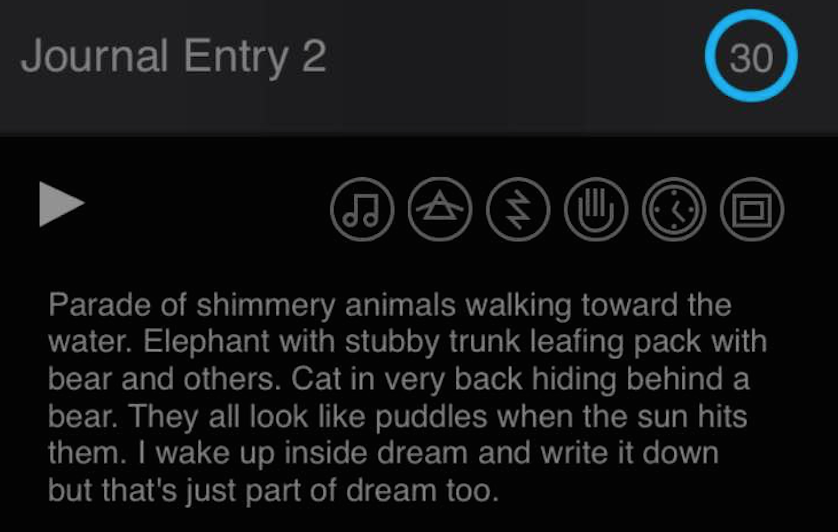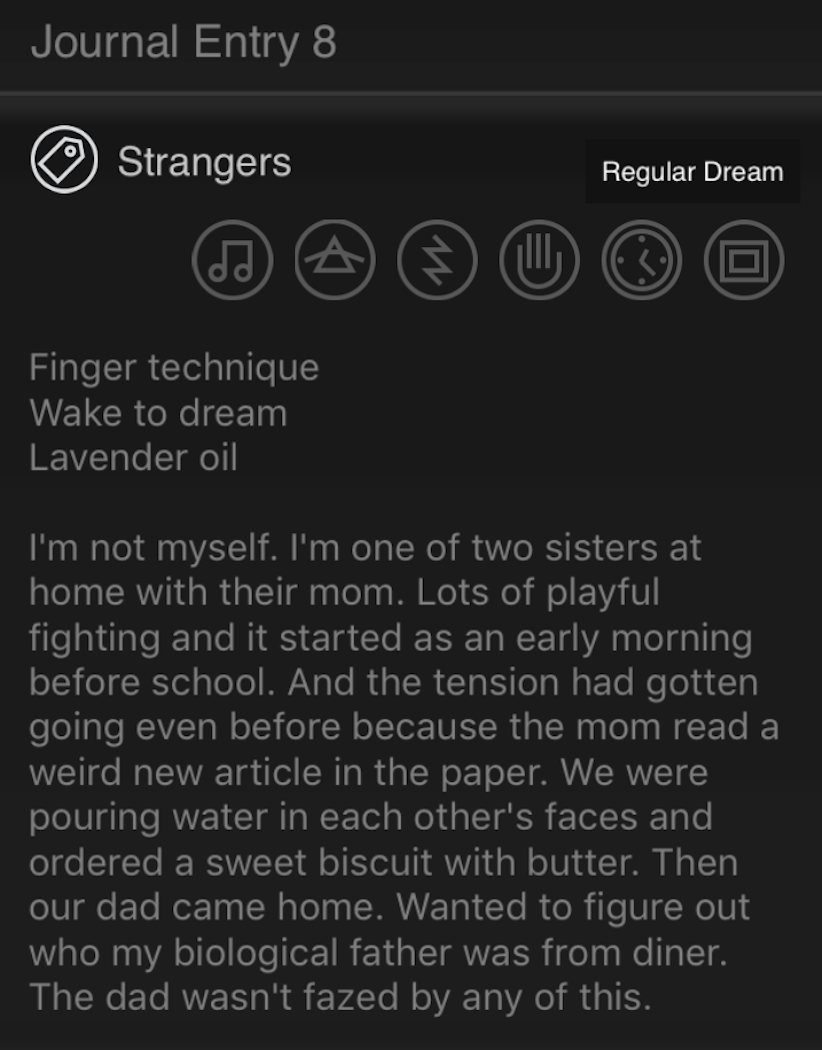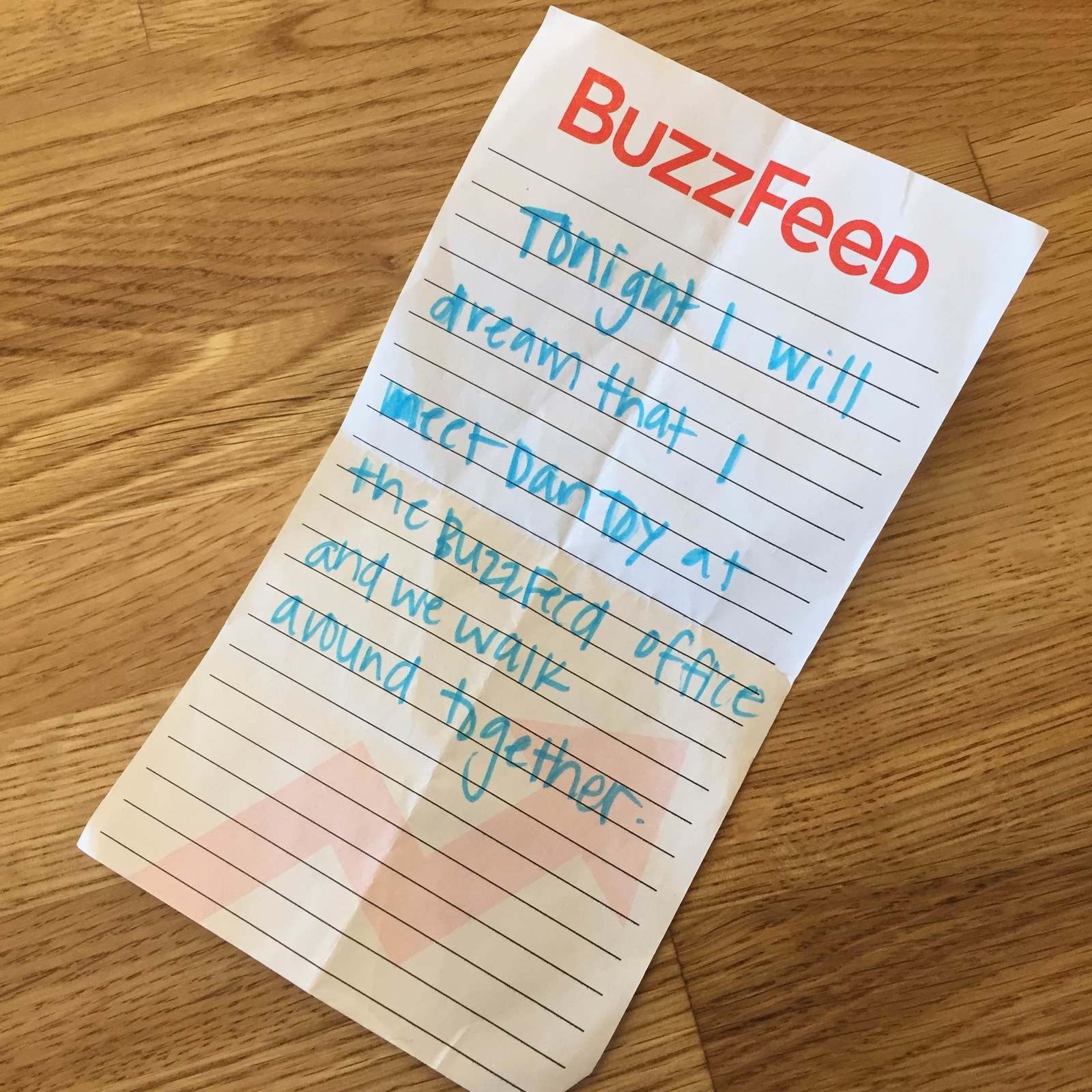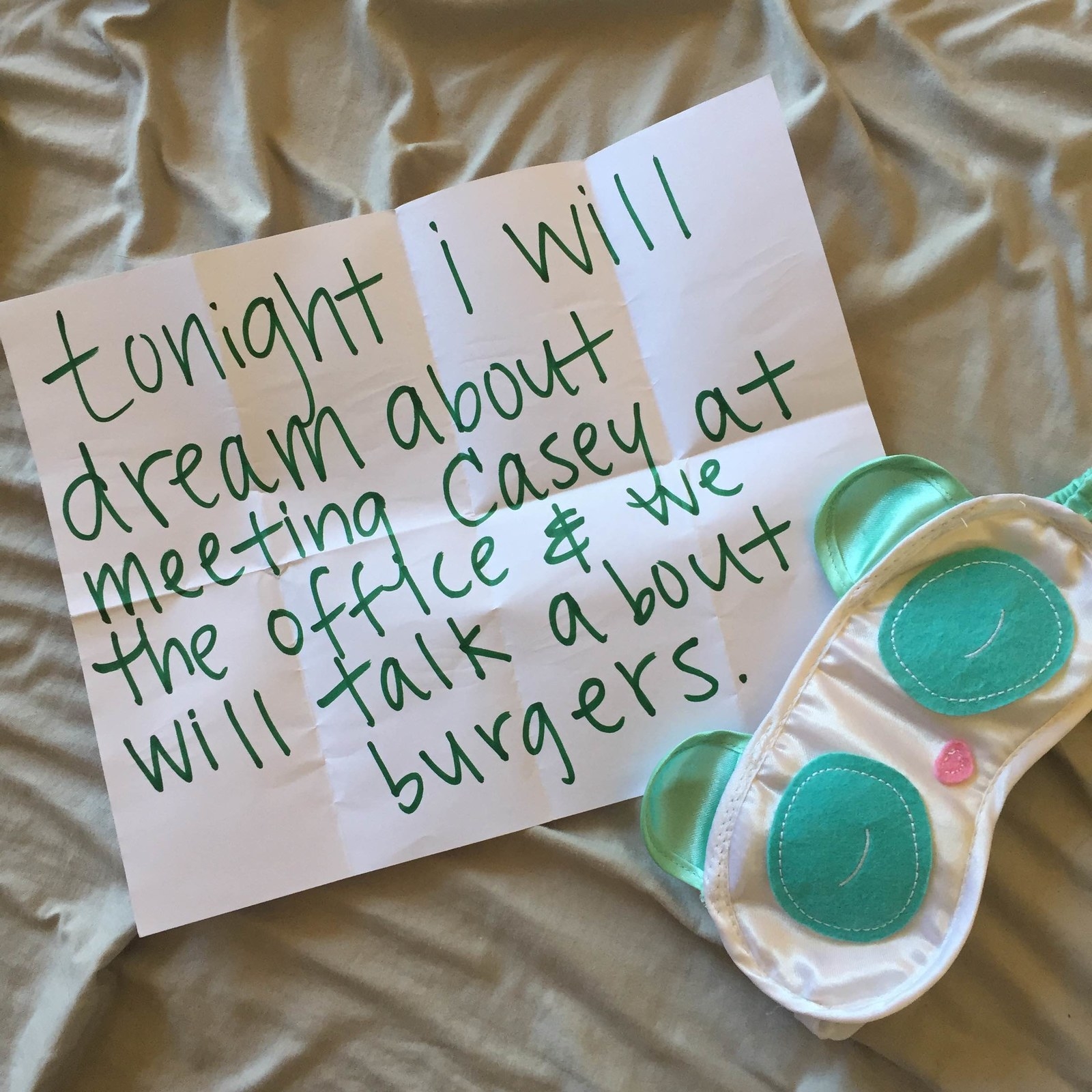As a kid, I liked to play what I called the Coffin Game. I’d cocoon myself in my bedsheets, lie completely still, and close my eyes until one of my parents walked in and found me. If I moved a muscle before then, I “lost.” Something about that game, about pretending to be dead and springing back to life, felt...soothing. Tranquil. Fun, even.
The act of attempting to lucid dream, I would come to find out, is kind of like a grown-up’s Coffin Game.
A lucid dream is a dream in which you become aware you're dreaming. It can range from simple awareness to something more complex, like being able to control what you do or see. So, in an effort to better understand how to control my dreams, I recruited my co-worker and friend Casey to help me test out a few methods. Our goal? To reach ~l u c i d i t y~, so you can too!

Before we jump into the techniques themselves though, there are a few things we suggest practicing and having ready first. (Give those plus-signs below a tap for more info about each item!)
Get in the habit of writing in your dream journal as soon as you wake up. Before you start any of the techniques below, you should be able to recall your dreams almost every morning. Performing 10–15 reality checks, or RCs, daily will also help you lucid dream, so make sure to practice those on the regular. Finally, be sure to meditate in bed every night. Relax your mind, clear your thoughts, and lie completely still. A calm body/mind is a great gateway for more controlled dreams.
All right, got all that? Are you suuure? Triple sure? OK, OK, we trust you. Now that you've assembled your nighttime dream aids and have practiced doing reality checks and meditation, it’s time to start LUCID DREAMING — or trying, at least!
Here. We. GO. (To sleep...)

Developed by psychophysiologist Stephen LaBerge, the MILD technique is a great place to start for beginners because it requires nothing but your own mind. Before bed, break out that dream journal of yours and identify a moment where you could've become lucid in a recent dream. (This moment should feel separate from reality, like encountering a flying emoji or having a conversation with an animal — the stranger it is, the easier it'll be to realize you're in a dream later via RC.)

As you fall asleep, lie completely still, revisualize this dream, and meditate on it. Keep telling yourself, and truly believing, you'll become lucid. (Dreamer pro tip: Count down from 100 while practicing — e.g., 100, I will enter my dream tonight; 99, I will enter my dream tonight; 98, I will..., etc.) Then let the power of your weirdo human brain do the rest!
Casey and I tried this method our first night (coincidentally both falling asleep around "60, I will enter my dream tonight" during the countdown) and saw immediate results in terms of remembrance. In the morning, I immediately and vividly remembered following a herd of shimmery pink animals, led by an elephant with a stump of a trunk, into a beautiful lake, while Casey recalled dream details throughout her morning: "In the shower it came back to me. I thought, That’s weird — Rob Kardashian and Blac Chyna were in my dream. My family was definitely not the Kardashians, but they were there."
While our dreams had ideal moments for us to become lucid, we both failed to perform the necessary in-dream RCs and therefore failed. But...it was a solid start!(?)
Level of difficulty: 😴
Rate of success: 💤💤💤💤, as this becomes super important for every technique that follows


Many consider the WBTB technique to be the holy grail of lucid dreaming, with some people swearing by its consistency and effectiveness. It's pretty much what it sounds like: You have to wake up, then almost immediately go back to bed. The trick here is to set an alarm for approximately five to six hours after you expect to fall asleep. This will wake you up right before your next REM cycle. When you get up, you'll likely feel groggy, tired, and annoyed — but that's a good thing! Stay awake for ~20 minutes to an hour to awake the analytical left side of your brain. Compose yourself, completely relax your muscles and body, and focus on your meditation and breathing. You can even do a MILD here! It's the perfect lucid dreaming cocktail, making it easier both to dream and, more importantly, recognize that you're dreaming. (Do an RC ASAP, like trying to breathe with your nose plugged or pushing your hand through a solid wall to trigger awareness in your dream.)
After doing a WBTB for the first time, I dreamed that my friends gathered together to show me a video of my own death (me kicking down an elevator wall, then stumbling and falling down the shaft with a splat). I even had a false awakening, where I thought I had woken up and written down the dream, but I did all of that while still in the dream. But hey, this was some serious progress! I just had to get those pesky RCs down...
Level of difficulty: 😴😴😴
Rate of success: 💤💤💤💤

The WILD method, though very similar to WBTB, requires a bit more mind work. It tends to happen more naturally during naptime or when you wake up in the morning and almost doze back off. Start with a WBTB if you can, but focus more on your hypnagogic state — the transitional stage smack-dab between being awake and asleep when you may experience crazy visuals, sounds, and sensations. But stay awake while you allow your body to drift off into la la land; this could help induce sleep paralysis or an out-of-body experience (OBE). These terms may sound scary, but if you remain calm and practice your RCs, they could be paramount in helping you control your dreams.
Though I've had sleep paralysis a few times in the past, my WILD never reached that stage during this experiment. I'd enter my hypnagogic state then get distracted, which put me back to square one. (Dreamer true story: For some reason, my hypnagogia consisted of Fonzie from Happy Days "jumping the shark" on an endless loop, which made me giggle and took me out of the zone.) Coincidentally, Casey, sleeping miles away, also dreamed of sharks but with more success: "I dreamed of some kind of threat, like a shark, in a swimming pool or the ocean, but no one was worried, like, This thing exists, but it’s fine.” She considered it a level-one lucid dream.
Casey: 1, me: 0.
Level of difficulty: 😴😴😴😴 because it's really hard to stay focused
Rate of success: 💤💤💤💤

This technique, unlike the others, is more modern and experimental. It's credited to a man named Peter Harrison, who goes by Pedro on the lucid dreaming forum ld4all, and has been amended and used by members of other forums, such as the Lucid Dreaming subreddit. This is our favorite version of VILD: Wake up and write down the dream you want to have later, fold the paper, and carry it in your pocket all day while reminding yourself of the details. (You should include some RCs in your description at specific plot points; Casey and I neglected to do this because apparently we're worse instruction followers than lucid dreamers.)
When it's time for bed, reread your dream and tuck it under your pillow. Then it's basically a mix of all the other methods from there.


During this technique, Casey brought up the importance of identifying her dream signs, i.e., moments in a dream that make it feel like a dream. They're basically the. perfect. time. to do an RC. Casey said she could better identify them after journaling. "I already know in a lot of my dreams, I’m with people I know but who don’t belong in the situation — people I’m not close with IRL anymore. But for some reason they're there, so I know it must be a dream." She posited that continuing to identify signs such as this one could help her better lucid dream in the future. After that, I started to pay more attention to what mine could be too.
One morning, we decided each of us would try to "meet" the other at the office in our dreams that night via a VILD. But when we had some watercooler dream-talk the next morning, we discovered something interesting: While neither of us dreamed about the other, we both dreamed about work. (Maybe using BuzzFeed stationery had something to do with it???)
In my dream, I found out I had a child with a co-worker, but I RC'd myself and knew it couldn't be true. Still, I ran into the same problem I was encountering every night: My mind wouldn't let me accept that I was in a dream. I faced the hard but not totally unexpected reality of our situation: We'd need a lot longer than a week to truly master this art.
Level of difficulty: 😴😴😴
Rate of success: 💤💤💤

Mom or Dad's signature meal. A bouquet of flowers. The scent of an ex-partner. It's obvious our sense of smell and our memories are inextricably linked. From Proust's 1913 In Search of Lost Time, in which he suddenly recalls a childhood memory after smelling and eating a "madeleine" dessert cake, to more modern-day studies, that link — that relationship — between smell and memory is both poetic and scientific. So it only makes sense that altering what we smell at night would also have an effect on what we dream.
When performing the SILD technique, some resources suggest using essential oils to help boost lucid dreaming, so toward the beginning of our experiment, Casey rubbed some lavender oil on her hands and pillow before going to bed. (Lavender in particular can be very calming and help relieve anxiety issues.) "This is the only TRUE success I had," she reported afterward. "In my dream, I saw a little ant, and I grabbed it and caught it. I fell asleep within my dream, had a false awakening, saw more ants, and knew I was dreaming. I fought the urge to believe the ants were real."
Although my musky man-smell room could probably use a dab (or 20) of lavender, I didn't have any oils and decided to skip this one for the time being.
Level of difficulty: 😴
Rate of success: 💤💤💤💤

You may be wondering if I only included this so-called VGILD technique because I just wanted to play a bunch of video games and fall asleep. Well, OK, guilty as charged…but it's not totally made-up, I promise. Some people claim it's helped them overcome their nightmares and fears, while researchers have even begun to look at the "electronic media effect" on reaction time and control in dreams, with video game playing having the strongest effect.
Casey opted out of this one, so I played enough for the both of us. Though I (sadly) didn't lucid dream afterward, I did notice more violent elements present in my dreams, which also happened to be in first-person (like the games I played). If you're a gamer or just need an excuse to become one, the VGILD technique could be an interesting — and fun! — way to help you better remember your dreams in the morning.
Level of difficulty: 😴😴 because you'll need a video game console and a few hours to shoot computer-generated enemies
Rate of success: 💤💤💤

The FILD technique is a bit more involved, but it essentially boils down to this: Start by doing a WBTB, then as you try to fall back asleep, move your index and middle fingers as if playing a piano. As you drift off, make the movements more subtle until you're barely twitching the muscles in your fingers. (More detailed instructions here.)
When Casey tried, she said the key is not to overthink it, though that's exactly what she did due to the exactitude of the exercise. "The tricky thing is that you’re limited to that narrow window of time, so you have to do it right before you fall back asleep. If you overthink it, then it’ll backfire, and you’ll end up waking yourself up more." Still, she ended up having a ton of vivid dreams from it, so maybe it's worth mastering.
Level of difficulty: 😴😴😴😴
Rate of success: 💤💤💤ish
So after all this, did we even lucid dream? Well, kinda, yeah! Each of us had moments of lucidity, but more importantly, we learned the importance of meditation, performing daily reality checks, and dream journaling, all of which helped us gain an upper hand on our dreams and increase our recall — not to mention we had a blast doing it! We both agreed we wanted to continue trying after this beginner's crash course.
So whether you want to attempt the methods above out of boredom (like an adult version of the Coffin Game) or attempt them in order to better understand your deepest desires, memories, and self, we hope you have the ~sweetest~ of dreams. And who knows? Maybe we'll even see you there.
Design by Dan Blaushild / © BuzzFeed
